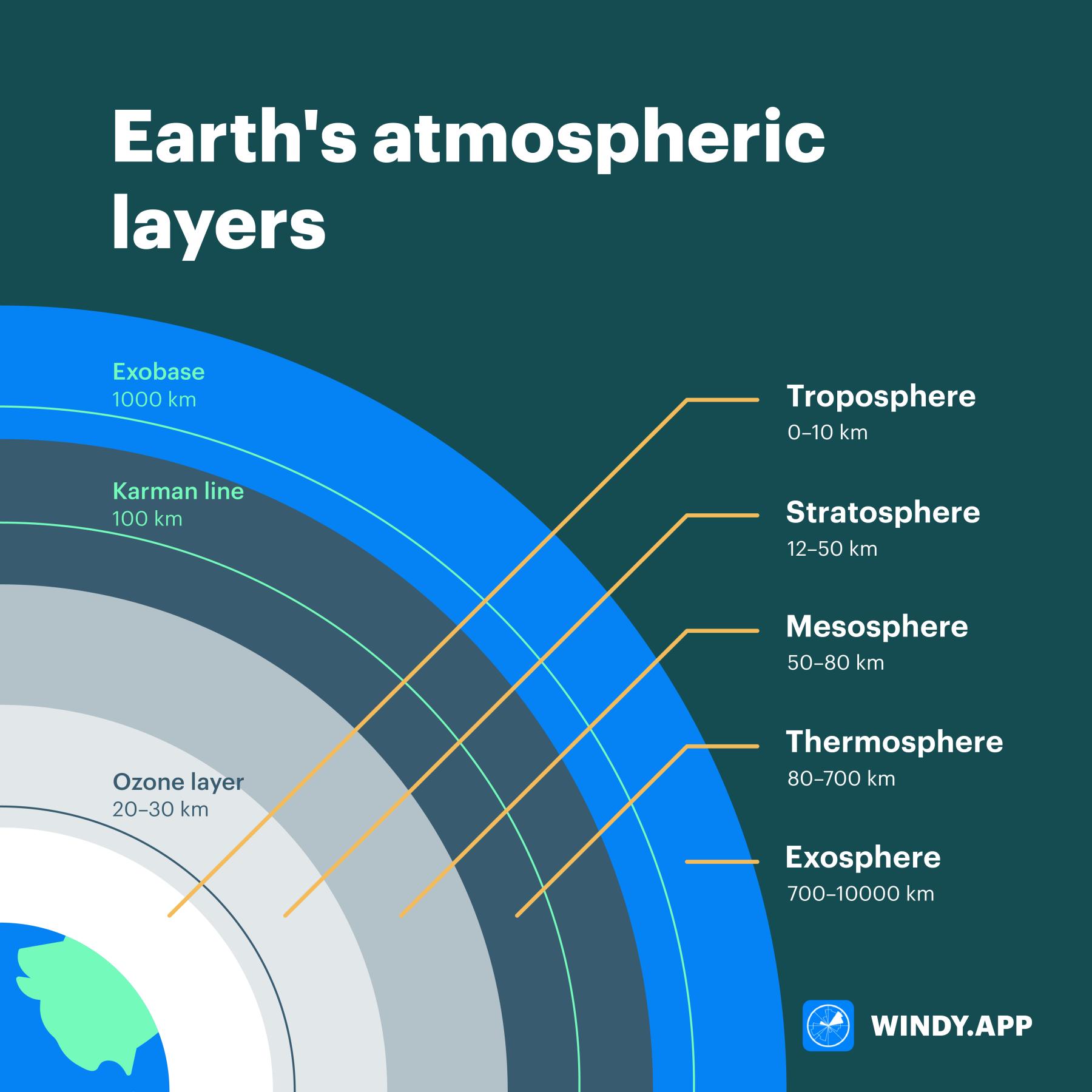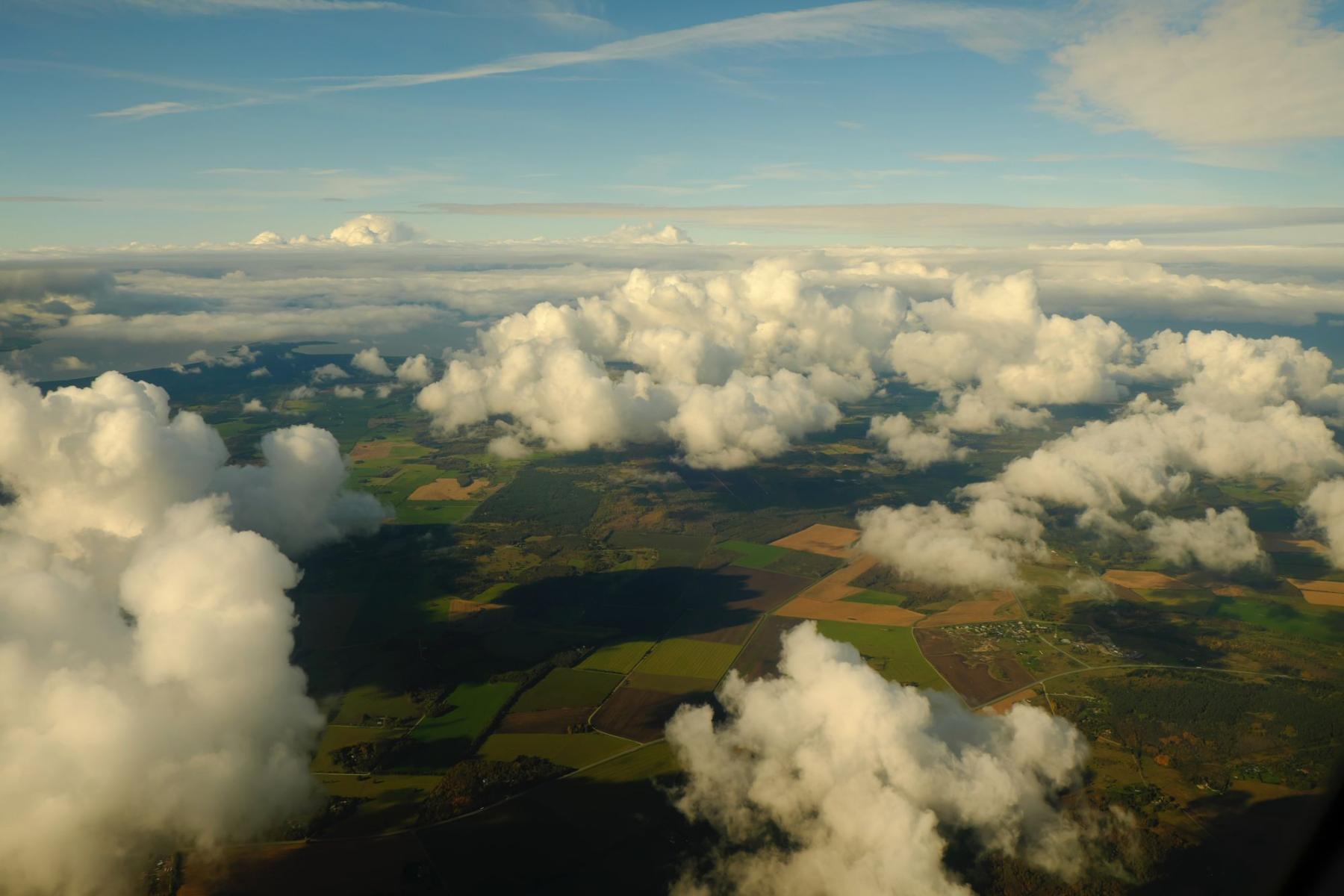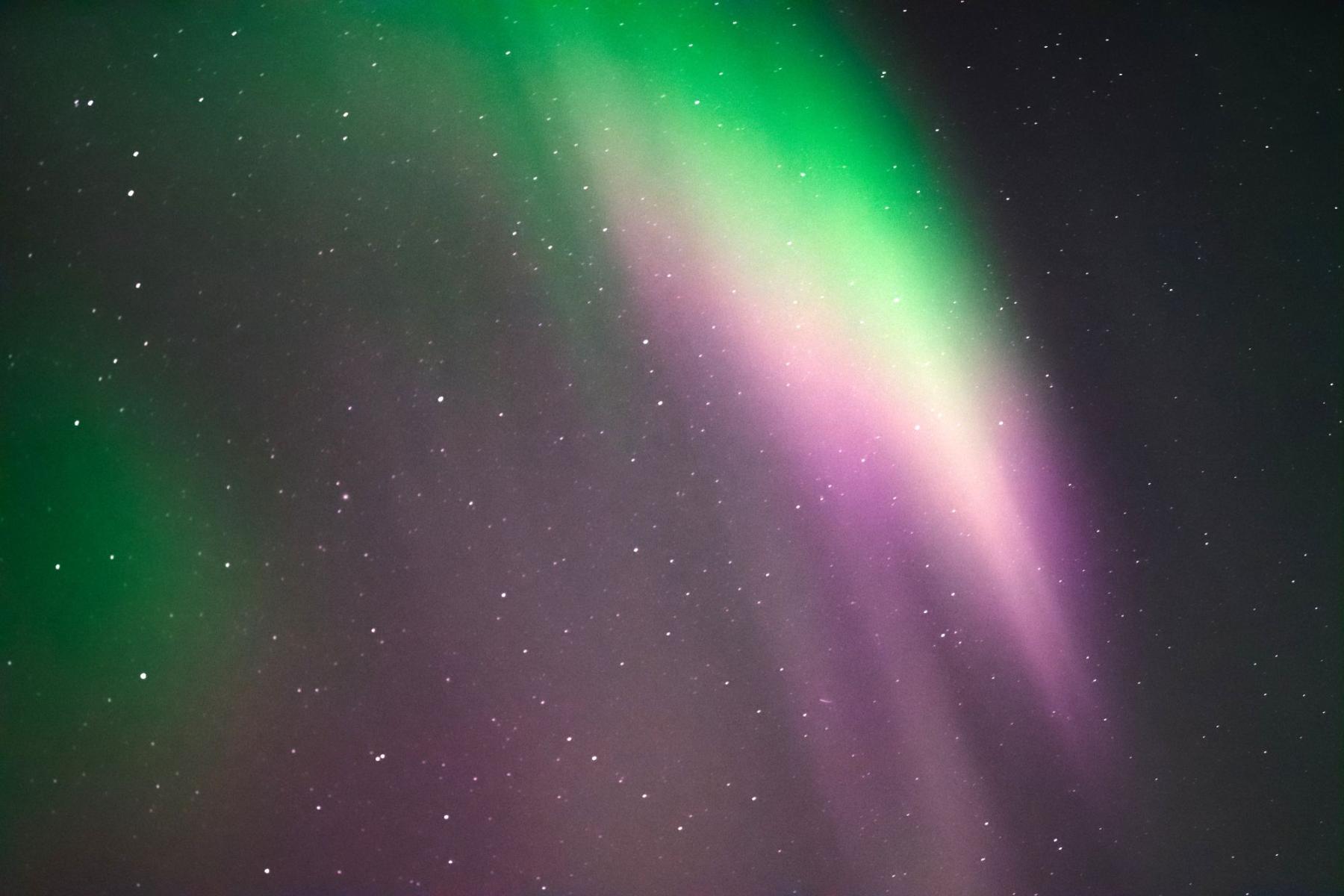
The five main layers of atmosphere. Explained
To the average observer, the Earth’s atmosphere seems to be absolutely solid. “Somewhere out there at the edge of the sky the space begins,” someone thinks, because he/she has seen the moon and the stars more than once. In reality the atmosphere is heterogeneous and composed of layers. In this new lesson of the Windy.app Meteorological Textbook (WMT) and newsletter for better weather forecasting you will learn what the layers of atmosphere are, how they differ and try to remember all of this with our help.
* * *
So, the Earth’s atmosphere has five main layers: the troposphere, stratosphere, mesosphere, thermosphere, and exosphere. Again: tropo-, strato-, meso-, thermo-, and exo-. And again: T, S, M, T, and E.

Earth's atmospheric layers. Illustration: Valerya Milovanova / Windy.app
The first three layers are called the “lower” or “lower atmosphere,” and the last two are called the “upper” or “upper atmosphere.
In addition to this, there are also the ozone layer, the Karman Line, the ionosphere, and several intermediate layers, called “atmospheric pauses,” through which it becomes clear that it consists of separate layers.
As a result, the total number of atmospheric layers is from five to seven or even ten, depending on the point of view.
Let’s talk briefly about each of the five main types next:
1. Troposphere

Miguel a Amutio / Unsplash
The troposphere is the first and closest to earth layer of the atmosphere in which we are all living. The height of this layer is from sea level (o km) to about 8–20 km, depending on the latitude. The troposphere is lower in the polar regions and higher in the tropics, on average it is about 12 km.
For comparison, the height of the troposphere is “only” three kilometers higher than the highest mountain in the world, Everest (8 km and 848 meters). Just slightly higher at the 10 km level passenger planes fly. That is, in theory, you can hike and climb up almost to the boundaries of the troposphere, or at least almost all of us have overcome this distance while flying.
Air temperature in the troposphere is from about +17 °C on average to −51 °C. Accordingly, the higher, the colder it is, about −0.65 °C every 100 meters. But only in this layer. Later, as you will see for yourself, the temperature behaves very differently: it decreases even more, remains unchanged, and rises very strongly. More: in the upper layers of the atmosphere the very notion of temperature changes because of the less dense air.
The main thing to know about the troposphere is that it has the most air, ~80% of the mass of the atmosphere. This is why those who do climb Everest, take selfies and immediately start descending to the base camp, rather than spend the night on the summit. There is almost no air and damn cold, and the descent to the bottom is as long and no less difficult than the ascent. They also try to catch the window of good weather, which are only a few days in the first half of May.
Another important thing is that almost all weather phenomena occur in the troposphere: clouds, precipitation, turbulence, and so on.
2. Stratosphere

Liane Metzler / Unsplash
The stratosphere is the second layer of the atmosphere from the earth, after the troposphere. Its height is from 12 km on average to about 50 km.
In contrast to the concept of “troposphere”, which not everyone knows, the expression “to launch something into the stratosphere” is very common. In particular, meteosondes — balloons to collect weather data — are launched from Earth into the stratosphere, as there is still ~20% of the atmospheric mass.
Also in contrast to the lower layer of the atmosphere, the air temperature in the stratosphere behaves differently: at an altitude of 11–25 km it continues to fall, but not as much as in the troposphere, to about −56.5 °C. This is why this region of the atmosphere is called the “tropopause” or a temporary stop in the temperature change. Then, between 25 and 40 km, things get even more interesting: the temperature rises by as much as 50 °C to +0.8 °C. This phenomenon is called an inversion. Then the temperature remains constant up to 50 km, which forms a new “pause” — the stratopause.
The main thing to know about the stratosphere is that it contains another important layer of the atmosphere — the ozone layer. It protects the Earth from ultraviolet radiation. It also explains temperature inversion. The height of ozone layer is between 20 and 30 km above Earth, although it differs depending on the latitude (higher in the tropics, lower in the polar regions). It also has ozone holes, including the most "famous" one in Australia.
Another important thing is that stratosphere is the highest layer reached by jet-powered aircraft, the mainstay of modern aviation. But fighter jets rise to heights of 18–20 km.
3. Mesosphere

NASA / Unsplash
The mesosphere is the third layer of the atmosphere, which follows the stratosphere and troposphere. The height of this layer is from 50 to 80–85 km.
Eighty-five km is very high, it is like climbing Everest 10 times. (But by the way, there is such a person in the world. On May 8, 2022, Nepalese mountaineer Kami Rita Sherpa climbed the highest peak of the planet for the 26th time. It took him 28 years, that is, about one climb a year). Another fact about this unprecedented altitude is that the mesosphere is capable of holding meteors that burn up in it, leaving fiery trails in the sky.
The temperature in the mesosphere also decreases with altitude. The mesosphere, or rather the mesopause, the next intermediate layer, is the coldest layer in the so-called “lower atmosphere” (the first three layers) with a maximum temperature of −90 °C.
The main thing to know about the mesosphere is that it contains only ~0.3% of the atmospheric mass, i.e. it contains the least amount of gases (air). For this reason, immediately following the mesopause is the Karman Line, or the boundary between earth and space at 100 km altitude, adopted by the International Federation of Aeronautics (Fédération Aéronautique Internationale, FAI). 99.99997% of the atmosphere is below this line. The line also divides the jet-powered aircrafts, for which the atmosphere becomes too thin, and rocket-powered aircraft.
Another important thing is that the mesosphere also produces noctilucent clouds, the highest in the atmosphere. This is due to the small amount of water vapor in this layer. You can see these clouds for yourself right from the ground under certain weather conditions and at certain times.
4. Thermosphere

Chong Wei / Unsplash
The thermosphere is the fourth layer of the atmosphere (yes, it still has layers!), which follows the mesosphere, stratosphere, and troposphere. The height of this layer is from 80 km to 600–800 km. It is also known as the “upper atmosphere”. It is the thinnest layer with about ~0.05% of the total mass of air.
There is no water vapor at all in the thermosphere, and hence no clouds, thanks to which they are formed. But in it (as well as a little bit in the next layer of the atmosphere) one can observe the widely known and perhaps most beautiful phenomenon — the Aurora Borealis. It occurs because this layer is saturated with free ions and electrons, which interact with the solar wind, giving birth to the famous “green curtains” as the peoples living in Canada, Scandinavia and Russia call the aurora. This part of the thermosphere is therefore also called the ionosphere.
The temperature of the thermosphere in the lower layer continues to drop from −90°C in the mesopause to −120°C, but then rises with altitude to about 1,200–2,000 °C to about 200–300 km and then remains unchanged in its upper layers, so this layer also forms another pause, the thermopause also known as thermobase. However, because of the large distance between gas molecules in this layer of the atmosphere, it is not as hot as it seems. The concept of heat is different in the upper atmosphere than before the Karman Line.
The most important thing to know about the thermosphere is that most space satellites fly in it (but also in the next layer), as well as the International Space Station at 408 km and the space shuttles that carry crews to it. That is, the thermosphere is of great practical importance for humans, because it helps to spread radio signals throughout the Earth and to study space.
Another important thing is that in such low dense layers of air, sound is also impossible. But the thermosphere plays an important role in atmospheric electricity (lightning) and forms the inner edge of the magnetosphere, another edge shell of the earth formed by its magnetic field.
5. Exosphere

NASA / Unsplash
The exosphere is the last fifth of the main layers of the atmosphere, following the thermosphere, mesosphere, stratosphere, and troposphere. The height of this layer is above 500–1,000 km, depending on solar activity, and up to 10,000 km.
This layer is also sometimes referred to as the upper part of the thermosphere and is also called the “dispersion zone”, because of the almost complete absence of gases compared to the lower layers that flow out into interplanetary space. The exosphere is too far above Earth for meteorological phenomena. But there are also a large number of satellites.
The temperature of the exosphere does not change much and more or less remains within the highs of the previous level from about +1,200 °C to +2000 °C or higher.
The main thing to know about the exosphere is that, as the last layer of the atmosphere, it has even less clear boundaries. For example, in February 2019, an analysis of data obtained by the SWAN instrument on the SOHO (Solar and Heliospheric Observatory) of the NASA / European Space Agency showed that the outermost part of the exosphere and the Earth’s entire atmosphere also called geocorona, extends about 100 Earth's radiuses or about 629,300 km — beyond the orbit of the Moon, equal to ~405,400 km at apogee.
Another important thing is that the Moon’s extremely low dense atmosphere is entirely exospheric. It is the same in the case of, for example, Mercury and the other planets.
* * *
So, we have understood what the main layers of the atmosphere are and how they differ. Let’s name them again: troposphere, stratosphere, mesosphere, thermosphere, and exosphere. And again: tropo-, strato-, meso-, thermo-, and exo-. And again: T, S, M, T, and E.
We also learned that there are four different “atmospheric pauses” between its layers, namely: tropopause, stratopause, mesopause, and thermopause (thermobase) — in short, one pause after each layer of the same name except the last, after which the real space begins.
Separately, there are also three special layers and a line: the ozone layer in the stratosphere, the Karman Line in the mesosphere, and the ionosphere in the thermosphere, where the Aurora Borealis appears in its most powerful form.
Around the earth is also a region called the magnetosphere or its magnetic field.
Let’s summarize the new knowledge about the main five layers of atmoshphere and their main differences also in a bit more visual way:
Troposphere
- 8–20 km, 12 km on average
- From +17 °C on average to −56.5 °C
- ~80% of the atmosphere mass
- Mount Everest (8,848 meters), propeller-driven aircraft and passenger planes, almost all weather phenomena occurs
- Tropopause
Stratosphere
- 12–50 km
- Ozone layer and ozone holes, jet-powered aircrafts limit
- From −56.5 °С to +0.8 °С
- ~20% of atmosphere mass
- Stratopause
Mesosphere
- 50–80 km
- +0.8 °C to −90 °C
- ~0.3% of atmosphere mass
- Mesopause
- Karman line (100 km), rocket-powered aircrafts limit
Thermosphere
- 85–800 km
- Northern Lights; satellites, rockets, shuttles and International Space Station (408 km); no clouds but electricity
- -120 °C to +1,200–2,000 °C or higher
- ~0.05% of the atmosphere mass
- Ionosphere
- Thermopause
Exosphere
- 500–1,000 km, up to 10,000 km (and even further up to 629,300 km)
- Satellites and spacecrafts
- +1,200–2,000 °C or higher
- Almost 0% of the atmospheric mass and therefore no weather
- Magnetosphere
Text: Ivan Kuznetsov
Illustration: Valerya Milovanova, an illustrator with a degree from the British Higher School of Art an Design (BHSAD) of Universal University
Cover photo: Filipe dos Santos Mendes / Unsplash
You can also find useful
Explore different types of contour lines
Latest News
Professional Weather App
Get a detailed online 10 day weather forecast, live worldwide wind map and local weather reports from the most accurate weather models.
Compare spot conditions, ask locals in the app chat, discover meteo lessons, and share your experience in our Windy.app Community.
Be sure with Windy.app.



